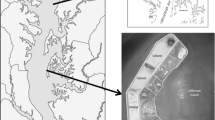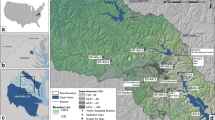Abstract
Dredging sediments from water bodies in Illinois is done topreserve reservoir capacity, maintain navigation and recreationchannels, and restore habitats, but the fate of the sediments is an issue. In anticipation of a major sediment dredging operationin Lake Peoria in the Illinois River, a retrospective study ofsediment placement operations was performed. Sedimentspreviously dredged from reservoirs and placed in retaining pondswere sampled along with adjacent upland soils which served asreferences. Sediments from the Illinois River above Peoria weresampled from islands, river bottom, and adjacent floodplain. Dredged sediment retention ponds initially support wetlandvegetation. After dewatering, the physical properties of sediments tend to become similar to upland soils and theretention basins are then able to support conventionalagriculture. Sediment organic matter content was similar to localreference surface soils, and soil pH of the sediments wasneutral or above. Sediment textures are dominated by silts and clays, with the Lake Peoria samples being most clayey. Calcium was the dominant cation in all the samples, and micronutrientsmeasured were in adequate supply for plant growth. However,because the Illinois River watershed includes industrial inputs,river sediments contained elevated levels of some metals, butthey were generally below levels of regulatory concern. Resultsindicated that properly handled dredge sediments could make highquality agricultural soils. In addition, sediment placement onpoor soils could improve their productivity.
Similar content being viewed by others
References
Bellrose, F. C., Havera, S. P., Paveglio, F. L. Jr. and Steffeck, D. W.: 1983, 'The Fate of Lakes in the Illinois river Valley', Biological Notes No. 119. Illinois Natural History Survey, Champaign, Illinois. 37 pp.
Demissie, M.: 1997, 'Patterns of Erosion and Sedimentation in the Illinois River Basin', Proceedings of the 1997 Governor's Conference on the Management of the Illinois River System, Oct. 7-9, 1997. Special Report No. 23. Water Resources Center, University of Illinois. Urbana, IL.
Dunker, R. E., Hooks, C. L., Vance, S. L. and Darmody, R. G.: 1995, 'Deep tillage effects on compacted surface-mines lands', Soil Sci. Soc. Amer. J. 59, 192–199
Fitzpatrick, W. P., Bogner, W. C. and Bhowmik, N. G.: 1987, 'Sedimentation and Hydrologic Processes in Lake Decatur and Its Watershed', Illinois State Water Survey, Champaign, Report of Investigation 107.
Illinois Environmental Protection Agency: 1997, 'Title 35: Environmental Protection, Subtitle G: Waste Disposal, Chapter I: Pollution Control Board, Subschapter F: Risk Based Cleanup Objectives Part 742, Tiered Approach to Corrective Action Objectives', Illinois Statutes.
Klute, A.: 1986, 'Methods of Soil Analysis (2nd ed.). Agronomy no. 9', American Society of Agronomy, Madison, Wisconsin.
Landin, M. C.: 1997, Proceedings: International Workshop on Dredged Material Beneficial Uses. Baltimore, Md. July 28 August 1, 1997. US Army Corps of Engineers, Waterways Experiment Station, Vicksburg, MS.
Lembke, W. D., Mitchell, J. K., Fehrenbacher, J. B. and Barcelona, M. J.: 1983a, 'Dewatering dredged sediment for agriculture', Trans. ASAE 26, 85–808, 813.
Lembke, W. D., Mitchell, J. K., Fehrenbacher, J. B., Barcelona, M. J., Garske, E. E. and Heffelfinger, S. R.: 1983b, 'Dredged Sediment for Agriculture', Res. Rpt. UIUC-WRC-0175. Water Resources Center, University of Illinois, Urbana.
MacDonald, D. D., Ingersoll, C. G. and Berger, T. A.: 2000, 'Development and evaluation of consensusbased sediment quality guidelines for freshwater ecosystems', Arch. Environ. Contam. Toxicol. 39, 20–31.
Martin, C. W.: 2000, 'Heavy metal trends in floodplain sediments and valley fill, River Lahn. Germany', Catena 39, 53–68.
Mehlich, A.: 1984, 'Mehlich No. 3 extractant: A modification of Mehlich Mo. 2 extractant', Commun. Soil Sci. Plant Anal. 15, 1409–1416.
Olson, K. R. and Jones, R. L.: 1987, 'Agronomic use of scrubber sludge and soil as amendments to Lake Springfield sediment dredgings', J. Soil Water Conserv. 42, 57–60.
Singh, K. P. amd Durgunoglu, A.: 1990, 'An Improved Methodology for Estimating Future Reservoir Storage and Capacity Applications to Surface Water Supply Reservoirs in Illinois', (2nd ed.), SWS Contract Report 493. Illinois State Water Survey, Champaign, IL, 39 pp.
Soil Survey Staff: 1993, Soil Survey Manual, USDA Handbook 18, US Gov. Print. Off., Washington, DC.
Soil Survey Staff: 1990, Soil Taxonomy, USDA Agricultural Handbook 436, US Gov. Print Off., Washington, DC.
Talkington, L. M.: 1991, 'tThe Illinois River: Working for Our State'. Misc. Publication 128, Illinois State Water Survey, Champaign, IL. 51 pp.
University of Illinois Extension: 1998, 'Illinois Agronomy Handbook, Circular 1360', College of ACES, University of Illinois, Urbana.
U.S. Environmental Protection Agency: 1995, 'A Guide to the Biosolids Risk Assessments for the EPA Part 503 Rule', EPA-832-B-005, Office of Wastewater Management, Washington, DC.
U.S. Environmental Protection Agency: 1997, 'The Incidence and Severity of Sediment Contamination in Surface Waters of the United States, Vol. 3: National Sediment Point Source Inventory', EPQ-823-R-97-008.
Author information
Authors and Affiliations
Rights and permissions
About this article
Cite this article
Darmody, R.G., Marlin, J.C. Sediments and Sediment-Derived Soils in Illinois: Pedological and Agronomic Assessment. Environ Monit Assess 77, 209–227 (2002). https://doi.org/10.1023/A:1015880004383
Issue Date:
DOI: https://doi.org/10.1023/A:1015880004383




